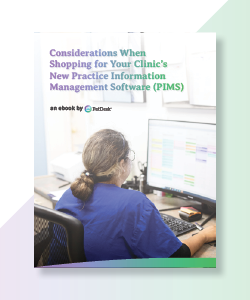If you do a quick Google search for “practice information management software”, you’ll come back with over 50 million results. That is an overwhelming amount of options when starting to look for a PIMS for your veterinary practice. So where do you start?
We’ve spoken with thousands of practices and learned about their experiences in choosing a PIMS. Given our unique insight, we’ve come up with a framework for choosing the best software for your practice.
Whether you are currently in the planning stages of opening up a new practice, or you have drawers full of manila folders of client information to transition over digitally, or looking to switch over to a new one – a PIMS is a step toward building an efficient practice. Beyond keeping things organized and secure, a PIMS is a vital foundation for being an effective health partner for current and future clients.
Before deciding on the perfect PIMS for your practice, here are some important questions to consider:
What problems are you hoping to solve with a new PIMS?
We’ve talked to many practices that invest in making a PIMS switch, only to find that it doesn’t resolve the issues they thought it would. Before you jump into shopping for a new PIMS, lay out the results you are hoping to achieve by switching platforms.
- Does your PIMS cause incorrect reminders to go out? If you haven’t yet, it may be time to do a cleanup of the information in your PIMS before considering switching
- Are you looking to save staff time by making reminders and confirmations easier? It might be time to look into a reminder system instead of a full PIMS switch.
- Does your PIMS lack integration with other software? Most software companies clearly indicate which PIMS they sync with. Always consider this when choosing your PIMS or the additional software to go with it.
Who should be involved in the decision-making process?
One way to help make the transition as easy as possible is to include the right stakeholders in the process of choosing software. This ensures that all individuals who will be affected by this change to your practice have a say and the best decision can be made so that all are “bought in”.
Now, you don’t have to ask every individual for their input – but consider who will be using the system and in what manner. For example, the front desk associate might use the PIMS differently than the doctor does. If you’re not sure, err on the side of caution and ask each department or role about their interaction with the tasks that would involve the new system.
Another way to think about it is to imagine yourself as one of your clients from the moment they call or walk into your practice. How will your PIMS impact their experience? How easy is it to use for the rest of your staff? Is it easy to understand and pick up – or will it take time to learn and adjust?
Think about how this change may impact your clients – will they have any benefit to the change? Thinking about the end result for your clients is a good way to ensure that your clients and patients will have the best experience possible in your hospital.
How should I budget for a PIMS?
For any business owner, cost and affordability are understandably the most important parts of making a key business decision. However, not all PIMS are made the same, so don’t let cost be the only factor you consider.
Having a budget makes sense, but realize that a PIMS is an investment into the future of your practice. Focusing only on cost can blind you from what could be the best opportunity to set your business up for future success.
What kind of PIMS can I choose from?
There are two major categories when it comes to PIMS accessibility:
Server-based
A server-based practice management software is installed onto your local server and your clients’ information and medical history is stored onto your server which is located on-site at your practice.
The benefit of this is that you know that all of your information is secure at your facility. The downside is that if for whatever reason something happens to your server, there’s a chance that it can affect your entire database.
Cloud-based
In a cloud-based PIMS, your clients’ information and medical history are stored and accessed online through a cloud-based server. This means that the information is stored in a server off-site, provided by the company as a service.
These cloud services are newer and typically more affordable making them increasingly popular. The upside to this feature is that you’ll be able to access your system from anywhere with internet access. The downside is that cloud-based systems may not have as many functionalities as the classic server-based systems.
What kind of time commitment will switching PIMS (or adding a new PIMS) take?
What kind of customer support will you get in switching from another PIMS or from paper files? How long do transitions like these typically take? Make sure you get an idea and timeline so that you can plan to do this during your slower seasons. Busy all year around? Consider a temporary hire for office help – if there is a veterinary school nearby, hiring students can be helpful for you with transferring files while benefiting them with experience working in a clinic.
Learning more about the software
Here are some methods to get the most holistic view of a software as possible.
- Ask about PIMS in veterinary-specific forums or Facebook groups.
Take advantage of your peers and consider the experiences that they had when implementing a software. Ask about the product, if integrating with other systems was easy, and what their experience was like starting up with the PIMS. - Look for reviews on the software’s website.
Of course, they will want to have only positive reviews featured on their own website, but it’s a good place to start to get a sense of their strengths and focus based on the reviews they want to share. - Find reviews from a third party source
Capterra is a good place to reference and check reviews for many different types of software. - Ask the PIMS provider for references
Keep in mind that references volunteer to speak on the PIMS’ behalf, so don’t be surprised if you are not given a list of clinics to call up immediately. The PIMS want to be respectful of their customers’ time and as such, you’ll need to get deeper in the process of learning about the system before getting access to reference contacts.
Does this PIMS sync with other software?
See if the PIMS is one that will sync with a variety of other systems. This will be an indicator that it’s a company that is serious about what they do and have thought about their end user (you and your team) and your business’ potential growth needs.
We often have clinics that reach out to PetDesk, but are disappointed to learn we aren’t able to work with their PIMS. They also mention they are not able to find any other partners that work with their PIMS. While it’s definitely important to find a system that will meet your needs immediately, a PIMS is the foundation of your practice.
Finding one that syncs with other necessary software is crucial and can save you from major challenges in the long run. Whether you plan to sell in a few years or hope to be at this practice for the next 30 years – find a system that is flexible enough to grow with you and fit your needs.
Questions to ask during this process:
- Does the PIMS address your specific needs?
- Who should be involved in looking into a PIMS at your practice?
- Will you need a server-based or cloud-based software?
- Does the PIMS offer references you can reach out to?
- What kind of software can currently sync with the PIMS?
- What is the post-sale process – do you have a single contact or a general support line to call? Do they offer live chat or any alternative ways to get help?
- If they do offer help, how quickly can they get back to you?
- Are they continuously working to make updates to the PIMS? What updates have they made in the last year?
Interested in talking to someone about a PIMS that can work for your business?
Sign up to talk to one of our technology consultants today about your clinic’s PIMS needs.







